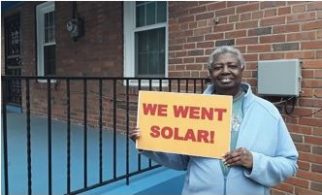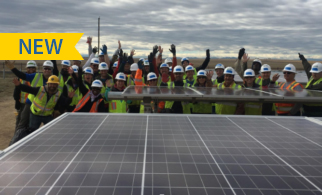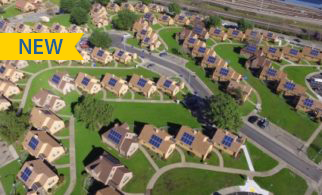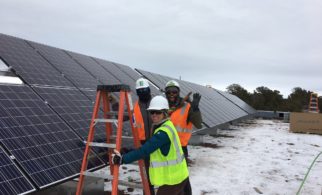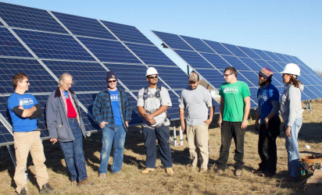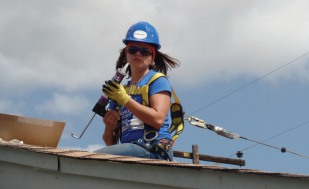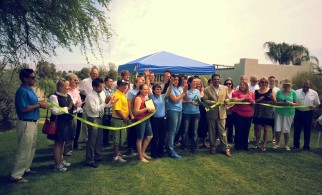Enabling Statute Examples
Guiding principles: Accessibility and Affordability, Compatibility and Integration, Sustainability and Flexibility, Consumer Protection
Barriers addressed: Cost, Physical Barriers and Home Ownership Status, Market Forces
Successful low-income solar policies and programs across the country (e.g. CA, CO, CT, DC) to date have a few things in common:
- They are long-term programs that encourage private and non-profit investment, designed specifically with low-income customers in mind.
- They have dedicated long-term funding sources (e.g. funded through the rate base or a special purpose charge, public purpose charges, riders, noncompliance funds, overall program budgets for solar, or revenues from carbon or renewable energy credit markets.)
- They have appropriate and differential incentives to eliminate the upfront cost barrier (e.g. rebates or grants, not tax credits).
- They maximize energy savings and consumer protections, and offer solar at no upfront cost to low‐income families.
- They have co-benefits like energy efficiency and job training built into the program design.
In order to accomplish these five objectives, enabling language in statute is essential to drive rulemaking and program design. Often times, the language is very simple. For example, in Colorado, C.R.S. § 40-2-127(5)(e) explicitly permits utilities to “give preference to community solar gardens that have low-income subscribers.” This language enabled the initial 5% project carveout requirement for CO community solar gardens, and evolved to the targeted low-income community solar programs adopted by Xcel Energy through a recent proceeding. Read about the evolution of Colorado’s low-income solar programs here, which was all driven by this statutory language.
While legislation and statutory language will need to be specific to local policy and market environments, the following are examples of statutes that have enabled equitable solar programs. These examples are meant to serve as references in creating equitable policies and low-income solar access. Policy and best practices are still emerging, so it is important to take a creative and pragmatic approach to ensure equitable access to your state or local solar program.
Establishing Low-income Inclusion & Preference
It is important to establish that policymakers and program implementers may give preference to low-income customers, ensure that clean energy programs are implemented in an equitable manner, and develop targeted policies and programs that suit their unique needs.
Colorado
The renewable energy standard statute, C.R.S § 40-2- 124(1)(e)(III) states that ”the commission shall encourage qualifying retail utilities to design solar programs that allow customers of all income levels to obtain the benefits offered by solar electricity generation and shall allow programs that are designed to extend participation to customers in market segments that have not been responding to the standard rebate offer program.”
The community solar garden statute, C.R.S.§ 40-2- 127(5)(e) states that
“Each qualifying retail utility shall set forth in its plan for acquisition of renewable resources a proposal for including low-income customers as subscribers to a community solar garden. The utility may give preference to community solar gardens that have low-income subscribers.” § 40-2- 127(1)(b) provides “It is in the public interest that broader participation in solar electric generation by Colorado residents and commercial entities be encouraged by the development and deployment of distributed solar electric generating facilities known as community solar gardens, in order to: …(II) Allow renters, low-income utility customers, and agricultural producers to own interests in solar generation facilities…” C.R.S. § 40-3- 106, specifies that a “reasonable preference” may be provided for low-income customers. Further, C.R.S. § 40-2-127(5)(a)(IV) states, “In addition, as necessary, the commission shall formulate and implement policies consistent with this section that simultaneously encourage: …(B) Ownership in community solar gardens by residential retail customers and agricultural producers, including low-income customers, to the extent the commission finds there to be demand for such ownership.”
Connecticut
Connecticut’s Public Act 11-80 requires that funding for energy conservation, demand reduction, and renewable energy projects be distributed equitably, and that the funds will reach low-income communities. See page 195-196 of Public Act 11-80 at https://www.cga.ct.gov/2011/ACT/Pa/pdf/2011PA-00080-R00SB-01243-PA.pdf.
Sec. 101. (NEW) (Effective July 1, 2011) Before approving any plan for energy conservation and load management and renewable energy projects issued to it by the Energy Conservation and Management Board, the board of directors of the Clean Energy Finance and Investment Authority or an electric distribution company, the Department of Energy and Environmental Protection shall determine that an equitable amount of the funds administered by each such board are to be deployed among small and large customers with a maximum average monthly peak demand of one hundred kilowatts in census tracts in which the median income is not more than sixty per cent of the state median income. The department shall determine such equitable share and such projects may include a mentoring component for such communities. On and after January 1, 2012, and annually thereafter, the department shall report, in accordance with the provisions of section 11-4a of the general statutes, to the joint standing committee of the General Assembly having cognizance of matters relating to energy regarding the distribution of funds to such communities.
Massachusetts
Massachusetts SB 1979 directs the Massachusetts Division of Energy Resources to develop a solar incentive program which “promotes energy justice and equitable access to the benefits of solar energy, including support of community-shared solar projects”
In creating the program, DOER must “…differentiate incentive levels to support diverse installation types and sizes that provide unique benefits, including, but not limited to, community-shared solar facilities, low-income solar facilities and municipal or other governmental entity-owned solar facilities.”
Illinois
The Future Energy Jobs Act (PA 99-0906) creates the “Illinois Solar for All Program,” intended to provide incentives for solar development in low-income communities. The program creates a number of different incentive pools to ensure that the full range of low-income community participants can access the benefits of solar energy. These include incentives for low-income distributed generation (single- and multi-family), community solar, and solar for non-profits and public facilities. Additionally, the statute includes two extra provisions to ensure the intent of the program to address solar and energy equity issues was realized. These include:
- Directing the Illinois Power Agency to define and provide special consideration to Environmental Justice Communities in implementing the Illinois Solar for All program. The Act sets as a goal that at least 25% of funds for the Low-Income Distributed Generation Incentive, the incentives for non-profit and public facilities, and Low Income Community Solar projects “be allocated to projects located in environmental justice communities.” The Illinois Power Agency will consult with the Illinois Commission on Environmental Justice and interested stakeholders on finalizing the methodology for defining environmental justice communities and will publish on its website draft maps and data and invite stakeholders to review and comment on the results. Importantly, requests for self designation will be allowed.
- Requiring incentives be offered to enable low-income ownership of community solar projects (i.e. not just subscription or lease-based models of community solar): “Incentives should also be offered to community solar projects that are 100% low-income subscriber owned, which includes low-income households, not-for-profit organizations, and affordable housing owners.”
Rulemaking and Program Design
Typically after the policy directive becomes law, rulemaking and regulations are critical to ensuring the success of the low-income solar program. Details for things like program administration, consumer protection and electricity bill/customer impact, and workforce development often are developed in rulemaking. A few jurisdictions have adopted similar regulations or program design measures that put the low-income customer’s experience first.
Administration:
Low-income solar and energy efficiency programs across the country have yielded the understanding that programs targeted at low-income households require a different approach than those for the general market. Marketing and communications need to be customized and standardized, the organizations delivering the message need to be trusted by members of the community, and more time needs to be dedicated to implementation in order to overcome existing barriers and protect consumers. A single or multiple third party program administrators can minimize administrative costs, develop consistent statewide marketing and outreach strategy, maintain program oversight and integrity, integrate workforce development, and ensure maximum benefits are provided to low-income communities. A few states have used this model successfully:
California
Read about California’s use of program administrators in SASH, LIWP, and SOMAH under our single-family and multifamily best practices pages. These programs have all leveraged third party program administrators to ensure dedicated attention and resources are given to implementing and scaling these programs.
The SASH Program is overseen by the California Public Utilities Commission (CPUC) and administered by a single statewide entity, a non-profit organization. Appendix B of the November 16, 2007 Order included program administrator selection criteria and requirements. The nonprofit Program Administrator is responsible for all marketing and outreach, application intake, developing financing models, installations, coordination with sub-contractors, semi-annual program reports, is the contractor of record, and ensures coordination with energy efficiency programs and free hands-on and paid training opportunities are available statewide.
California’s Low-Income Weatherization Program (LIWP) provides an example of a diverse program offering tasked to a single program administrator that uses dedicated sub-contractors based on program type. LIWP installs solar photovoltaics (PV), solar hot water heaters, and energy efficiency measures in eligible low‐income single family and multi‐family dwellings in disadvantaged communities. Each of those offerings is executed by a qualified nonprofit sub-contractor to ensure cost effective and efficient delivery.
The new Solar on Multifamily Affordable Housing Program (SOMAH) will provide incentives for the installation of solar distributed generation projects sited on existing multifamily affordable housing. Decision 17-12-022 called for a program administrator, stating “A single statewide PA will also be able to coordinate marketing and education efforts, ensuring consistent messaging to and treatment of potential participants. Such a structure should simplify communication about the program and make it more accessible to participants. For these reasons, we choose to have a single PA oversee this program statewide.
Illinois
Illinois’ Future Energy Jobs Act directs the state agency responsible for implementing the low-income Illinois Solar for All program to select a program administrator:
“(5) The Agency shall issue a request for qualifications for a third-party program administrator or administrators to administer all or a portion of the Illinois Solar for All Program. The third-party program administrator shall be chosen through a competitive bid process based on selection criteria and requirements developed by the Agency, including, but not limited to, experience in administering low-income energy programs and overseeing statewide clean energy or energy efficiency services.”
The Illinois Solar for All Program will serve a number of diverse customer groups, including low-income homeowners, renters, affordable housing owners, nonprofits and solar developers, and will offer support for varying types of solar projects from distributed generation rooftop to community solar. Administrator(s) will need to understand these complexities and have direct experience with these services and these communities in order to develop effective programs that pass benefits on to the intended audiences.
Oregon
Section 22 of Senate Bill 1547, passed by the 2016 Oregon legislature, requires a program for the procurement of electricity from community solar projects. The legislation also requires the determination of a methodology by which 10 percent of the total generating capacity of the projects operated under the program will be made available for use by low-income residential customers. This community solar program will have a dedicated program administrator, as well as a low-income facilitator to ensure successful implementation of low-income program targets.
Maximizing Benefits:
Low-income solar programs can be designed by statute in a way that maximizes customer benefits. Key benefits include ensuring significant customer savings, coordination with complementary services like energy efficiency, as well as encouraging economic opportunity through consumer education and job training. Maximizing benefit is integral to the success of low-income solar programs.
California Solar on Multifamily Affordable Housing Program
In December 2017, California issued a Decision Adopting Implementation Framework for Assembly Bill 693 and Creating the Solar on Multifamily Affordable Housing Program (“SOMAH”). Consistent with AB 693, the new SOMAH program will provide incentives for the installation of solar distributed generation projects sited on existing multifamily affordable housing. The Decision does not have a mandatory bill reduction percentage, but the Decision does have a requirement that tenants receive 100% of the economic benefits of the virtual net metering (“VNEM”) credits allocated to them.
“In order to protect tenants from bearing any additional costs through increased rents, adjustments to utility allowances, or other mechanisms, we direct the PA [Program Administrator] to establish the appropriate documentation requirements, to be included in their proposed SOMAH Program Handbook, for applicants to demonstrate that 100% of the economic benefits of the generation system will be reserved for tenants through the life of the system.”
District of Columbia Solar for All
The Renewable Portfolio Standard Expansion Amendment Act of 2016 (The Act), effective October 8, 2016, established the District of Columbia’s Solar for All Program (Solar for All). The Act intends to expand DC’s solar capacity, to increase the amount of solar generated within the District, and to provide the benefits of locally-generated solar energy to low-income households, small businesses, nonprofits, and seniors. Funded by the Renewable Energy Development Fund and administered by DOEE, Solar for All’s specific targets are to provide the benefits of solar electricity to 100,000 low-income households (at or below 80% Area Median Income), and to reduce their energy bills by 50% (based on the 2016 residential rate class average) by 2032. Solar for All includes single-family, multifamily, and community solar projects.
Colorado Low-Income Community Shared Solar Demonstration Project
Colorado Energy Office’s Low-Income Community Shared Solar Demonstration Project provides no-cost community solar subscriptions to low-income residents in rural electric cooperative territories and included a target to bring customers within an average state energy burden, as summarized on page 4 of project report. The project was designed to with the goal of bringing low-income Coloradans to within the state’s average energy burden. Of the eight projects, six projects had 50% Targeted Cost Savings as Percentage of Utility Bill, one project had 30% and one project had 15-50%.
Consumer Protection:
Measures to prevent misinformation and eliminate risks for predatory or subprime financing schemes should be embedded throughout low-income solar program regulations and design. Specific consumer protection measures for low-income solar programs should be mandated.
California Single Family Affordable Solar Housing Program
California’s Single Family Affordable Solar Housing (“SASH”) program contains a number of consumer protection provisions. For example, in its initial program design in 2007, the California PUC declined to allow for third-party ownership (TPO) of solar arrays in the program, stating, “We are concerned with ensuring that any third-party ownership arrangements provide long-term benefits to low-income homeowners.” In revisiting the SASH program in 2015, however, the CPUC found a TPO model would be beneficial in helping the program meet its installation targets with reduced funding, as long as the following consumer protection standards were incorporated:
- Ensure SASH customers receive at least 50% of the savings, as compared to standard utility rates, from the solar generating equipment;
- Reduce or eliminate barriers for customers with poor credit (low FICO scores) to qualify and participate;
- Address concerns that homeowners may have about moving or selling their home during the TPO contract term;
- Cover maintenance, operations, inverter replacement, and monitoring;
- Prohibit liens on homes;
- Minimize the risk to the low-income customer that the solar system would be removed for delinquent payments;
- Ensure that all costs are apparent and up front and that there is no risk that the TPO deal would result in an additional financial burden to the family;
- Standardize financial terms for low-income customers where possible;
- Protect the customer against terms that could change after contract signing;
- Require that TPO agreements note the potential for additional costs associated with the contract, if applicable;
- Require the TPO provider to clearly explain that rate changes will affect the economics of a power purchase agreement; and
- Require that TPO agreement provisions spell out what happens in the event that the solar financing company defaults.
Illinois Solar for All Program
As outlined in the Illinois Power Agency’s Long Term Renewable Resources Procurement Plan a number of consumer protection measures are required in Illinois’ Solar for All program, including the following:
- Low-income residential customers cannot have upfront costs and their experience must be cash flow positive.
- For low‐income customers, loans should not be secured by the program participant’s home or home equity.
- Marketing and contractual materials must be in the language requested by the customer.
Workforce Development:
States like California and Illinois have incorporated job training programs into their low-income solar programs. This is an important element for providing a basis for economic growth and employment opportunities in low-income communities. Successful incorporation of job training should include specific provisions for placing job trainees into employment.
California
In California’s low-income solar programs, job training opportunities include both direct installation experience, as well as design/engineering, and project coordination experience. This provides opportunities for trainees to gain valuable experience in all parts of solar installation, though the bulk of the trainees tend to be directly involved in the installation on-site.
In the California MASH Program, in order to be eligible for an incentive, the contractor agrees to hire at least one student or graduate of a job training program for at least one full paid day (8 hours) of work for each 10 kilowatts (kW) of system size up to 50kW. In the California, the SASH 2.0 Program is legislatively mandated to include a job training opportunity at every installation.
Enabling statute for the forthcoming SOMAH program requires the Commission to establish local hiring requirements to promote economic development in disadvantaged communities.
Decision 17-12-022 adopts similar job training requirements to MASH for the SOMAH program, with some additions.
Illinois
The Future Energy Jobs Act referenced job training to ensure that the job trainees supported by the Commonwealth Edison (ComEd) job training programs established under the Act participate in Solar for All installations.
The “solar training pipeline program” notes “[p]rojects must include job training opportunities if available, and shall endeavor to coordinate with the job training programs described in paragraph (1) of subsection (a) of Section 16-108.12 of the Public Utilities Act.” ComEd will spend $3M in each of 2017, 2021, and 2025 to train installers. The job training program is to be “designed to ensure that entities that offer training are located in, and trainees are recruited from, the same communities that the program aims to serve and that the program provides trainees with the opportunity to obtain real world experience.”
Another part of the statute also directs that in order to take advantage of the Low-income Distributed Generation Incentive, “[c]ompanies participating in this program that install solar panels shall commit to hiring job trainees for a portion of their low-income installations” and “an administrator shall facilitate partnering the companies that install solar panels with entities that provide solar panel installation job training.”
Evaluation & Adaptation
Low-income solar programs should include independent program evaluations at regular intervals to ensure the program can continually adapt and respond to the needs of the communities and families it is serving. The evaluation should be based on objective criteria developed through a public stakeholder process, including participants and organizations in environmental justice and historically underserved communities. The evaluation should be used, as needed, to revise and adapt the low-income solar program.
California
Both the SASH and MASH programs undergo a comprehensive biennial program evaluation conducted by an independent third-party contractor selected by the CPUC. The first evaluation occurred in 2010-2011 when the programs were nascent (only approximately 50 SASH projects and 0 MASH projects had been completed), and the second evaluation occurred in 2013-2014 when the programs were more fully developed. In addition, both programs are audited regularly to ensure the program administrators are accurately issuing incentive payments and qualifying eligible properties and households for the programs. The CPUC issued an RFP for evaluators. Navigant consulting won both cycles, as well as the general market CSI evaluations. In each evaluation cycle, a group was put together of Navigant, the CPUC, and the program administrators to plan out the report, give feedback on what should be included, feasibility of different options, etc. The evaluator contacted clients, job trainees, etc. for interviews and the program administrators helped orchestrate the interviews and reviewed draft reports.
And the recent SOMAH Decision requires that every three years an independent evaluator will evaluate the effectiveness and efficiency of both the PA and the SOMAH program overall.
Illinois
The Future Energy Jobs Act not only requires an independent evaluation of the Illinois Solar for All Program, but also .
“At least every 2 years, the Agency shall select an independent evaluator to review and report on the Illinois Solar for All Program and the performance of the third‐party program administrator of the Illinois Solar for All Program. The evaluation shall be based on objective criteria developed through a public stakeholder process. The process shall include feedback and participation from Illinois Solar for All Program stakeholders, including participants and organizations in environmental justice and historically underserved communities. The report shall include a summary of the evaluation of the Illinois Solar for All Program based on the stakeholder developed objective criteria. The report shall include the number of projects installed; the total installed capacity in kilowatts; the average cost per kilowatt of installed capacity to the extent reasonably obtainable by the Agency; the number of jobs or job opportunities created; economic, social, and environmental benefits created; and the total administrative costs expended by the Agency and program administrator to implement and evaluate the program.”
